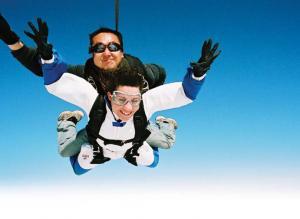Human Flight
By Matthew Heath
For the expat resident Japan has a lot going for it; within a couple hours in winter there’s skiing, in summer the beach and a variety of interesting weekend excursions, whatever may tickle one’s fancy. What may be less obvious is skydiving in Japan. There around only 500 active skydivers here so it is still very much a minority sport. In under an hour from Asakusa one can be at Fujioka Station in Tochigi Prefecture and five minutes from the drop-zone.
 Photography courtesy of Matthew Heath
Photography courtesy of Matthew Heath
I am used to jumping mainly in Spain and California, where the infrastructure is well-developed; they have several planes with sophisticated manifesting and announcement systems, kit shops, restaurants and lots of skydivers. Advanced Air Sports in Tochigi operates out of a field with two trestle tables, a couple of tents, a helicopter with a five jumper capacity and a handful of two-way radios. That said, safety is up to the highest of standards.
Skydiving as a hobby falls into two categories solo jumping and experiencing free-fall by doing a tandem skydive. The latter involves a short briefing and then the jump itself would typically be from 12,500 feet, strapped to the instructor, with around 50 seconds of free-fall and 5 minutes of parachute ride. The way that most come to it will be through tandem experiences that leave them hooked. According to the jumper’s wishes the instructor will make the ride as docile or exciting as required.
The first jump, (and probably the first 20 or so) induces sensory overload. The plane ride seemed short and I spent much of it asking myself why I was doing this. Then you jump and remember until the next time. Skydiving is not inherently dangerous—it is just the image it has. The kit is designed to fly and experiments with bad packing will generally still produce a perfectly good canopy after deployment. As long as kit is well maintained and inspected religiously it should never cause any problem. However, the more modern high-speed wing like canopies need speed to generate lift, which allows one to land safely in the ‘swooping’ style that has become so popular and slightly controversial. Too slow and there is no lift—in this sense height and speed are on our side. This speed is created by turning; doing this incorrectly is what causes nearly all skydiving accidents. Getting it just a little bit wrong can make a big difference— either landing at ground level or setting up to land at one or two meters below ground level, the former being more comfortable. Tandems are done with very large low-performance canopies that come down to earth gently, so this does not apply. I find it worth reminding beginners that the tandem master would not be doing this if it were not safe and he has done it hundreds of times before. However, logic is one of the first casualties of fear!
The feeling on exit is euphoric. I have completed several hundred skydives and I still get a thrill out of it. The comfort that comes with a little experience does not mean that one loses the buzz. Initially, there is the exhilarating of acceleration and then comes the flight—one has little sensation of falling, more of flying. After the exit it is possible to catch a view of Mt Fuji until it goes out of sight at about 9000 feet. For a one-off experience Tochigi is a great place to do it but I would not bank on remembering much of it. Sensory overload means your brain does not record. That is why they have a cameraman wearing both a stills SLR and video camera to capture the moment for posterity.
If you have any inkling that throwing yourself out of a plane might prove to be good fun then don’t hesitate: learn to skydive, have confidence in the kit and enjoy the experience of ‘human flight.’







Comments
Craig (not verified)
March 27, 2008 - 09:18
Permalink
Skydiving in Tochigi
Great article. Love to try it!
Can you provide a web or email address?
Anonymous (not verified)
September 11, 2008 - 15:57
Permalink
Skydiving in Japan
This was a great post that's got me all fired up for jumping for my first time. However, can you please give me some contact info of where I can go to dive? I missed the tour that my base offers and I'm trying to do it on my own. Thank you very much in advance
Anonymous (not verified)
June 19, 2011 - 22:07
Permalink
GREAT info!!!
Hi,
I'm already a solo skydiver, doing mainly -though not exclusively- free-style with almost 100 jumps, and I'm moving to Japan in September, which is why I'm looking for Japan DZs. I've found 3 so far through USPA's website, but they don't mention the prices per jump, nor if the people there speak English...
Thanks for all additional info you can give me (any cute Japanese girls doing skydiving???)
David V.
P.S: I'll be checking out this page for any response since I don't like giving away my e-mail address.